
Need for Speed: Heat is the latest entry into the Electronic Arts series that needs no formal introduction. Need for Speed™ is, after all, one of the top selling video game franchises of all time. Developer Ghost Games has a lot to celebrate with the release of Heat, record-breaking sales [for the series] notwithstanding. If Ghost Games’ Twitter is to be believed, Need for Speed: Heat represents the most successful Need for Speed title launch in so many years, and we can see why. The game mixes some of the best aspects of the series’ historical favorites, but it is not without its flaws. Read our full review to find out how NFS: Heat stacks up to the rest of the franchise.
Need for Speed: Heat
Publisher: Electronic Arts
Developer: Ghost Games
Platforms: Windows PC (Reviewed), Playstation 4, Xbox One
Release Date: November 8, 2019
Players: 1
Price: $59.99 Standard, $69.99 Deluxe

It can be a treat to cruise around the open-world, Miami-inspired Palm City for newcomers and arcade-racing veterans alike.
Let’s get this out of the way: Need for Speed: Heat does not mark the pinnacle of the series, much less of the genre at large. In all respects, the game doesn’t make any attempt to reach new heights.
Rather, Heat is a game that seeks to return to familiar plateaus. There are a great many familiarities and tropes being rehashed here.
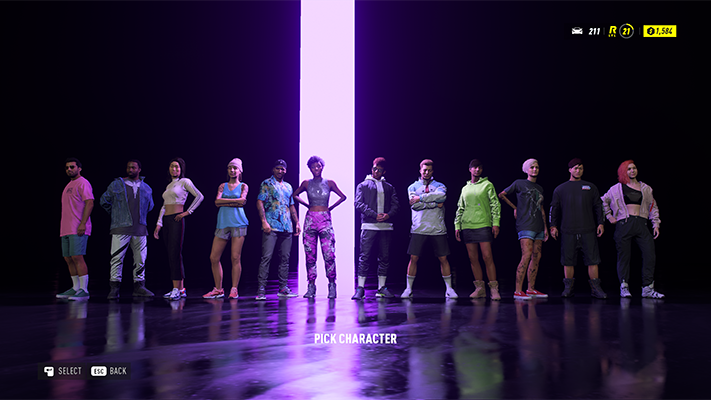
Stop me if you’ve heard this one: The nameless up-and-comer, loaded up with naive ideals and questionable motives, teams up with cliche, forgettable figures in the hip-hop infused racing underworld to burn rubber against the hard-ass, street-racing police unit on the fast-meets-furious path to underground fame and fortune.
The story is everything you never wanted and have gotten time and again. If you’re the rare exception that cares about that sort of thing, you should turn back now. The rest of us, however, did not come here for the story, so this is the last we’ll mention it.

You’ll begin the game by selecting a starter car from a triad of hoopties: a Ford Mustang ’65, a BMW M3 Evolution II ’88, and a Nissan 180SX Type X ’96.
Okay, hooptie is an exaggeration, but these cars are pittance compared to the several thousand pounds of pure mechanical f#%kery you’ll be driving later on.
These cars setup a dichotomy familiar to fans of the genre: American Muscle vs Import Tuner–and a little something down the middle for the indecisive among us. Admittedly, for the first hour or two of the game, your selection here matters.
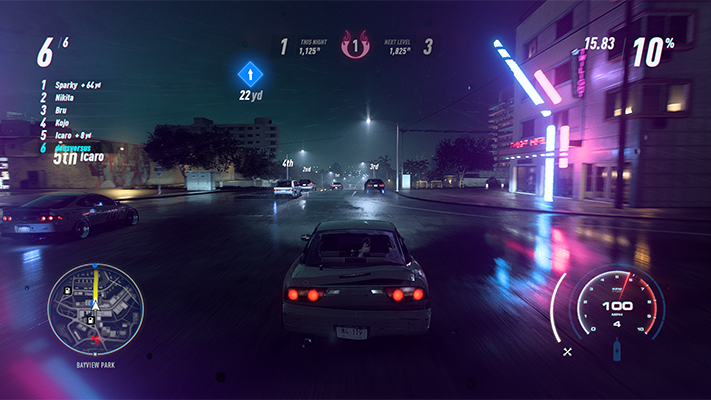
The first few minutes can make or break the experience of any racing game. It is in these initial moments that we get a feel for the primary mechanic of the game: the driving.
If we like the way the game controls, we keep playing. If we don’t… well, we don’t.
Luckily, all three of the starter options present a good feel for how the game plays overall. They, for the most part, control how you would expect them to (albeit within the framework of Heat‘s unique physics).
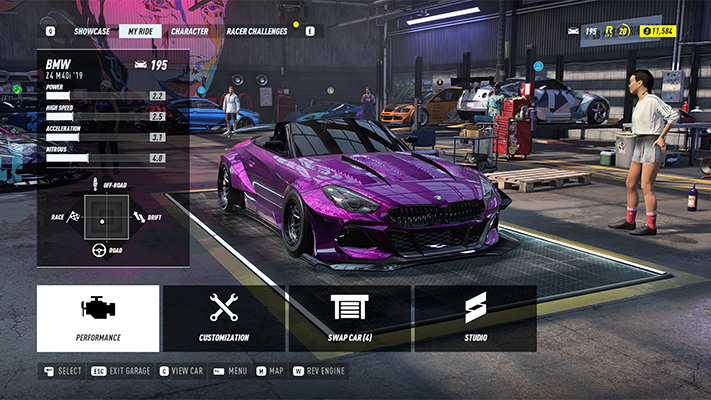
There’s a fair amount of difference between “car types”, but the aforementioned dichotomy is relatively false.
Regardless of what car you start with, the mechanics of how it controls and what types of races it specializes in can be adjusted with upgrades which, even on the same performance tier, come in a variety of options (e.g. drift differential vs race differential, on-road tires, vs off-road tires, etc.).
Further, as hinted above, the specialization of your vehicle goes beyond a single two-point axis of “drift vs race”. The game also factors in “on-road vs off-road” and offers a variety of upgrades which affect these two axes simultaneously (e.g. drift + on-road, drift + off-road, race + on-road, etc.).
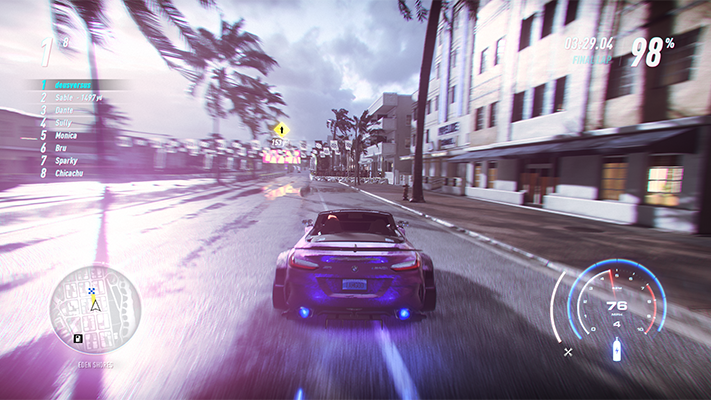
Need for Speed: Heat, like all Need for Speed games, is not a racing simulator–a related but vastly different genre. Fans of Gran Turismo and Project CARS need not apply. Even adherents of semi-sims like Forza will want to sit this one out.
This is very much an arcade racer and any attempts at driving-proper will be met with ennui.
The game demands you master the art of drifting, which quickly becomes the standard mode for every turn greater than 15-degrees.
Those accustomed to breaking into the turn, hitting the sweet spot, and powering out will need time to adjust. Steering in Heat is a little stiff.
The game has a hard turning-radius wall that will require to you slow significantly [should you choose not to drift] to avoid understeering, costing you precious fractions-of-seconds.
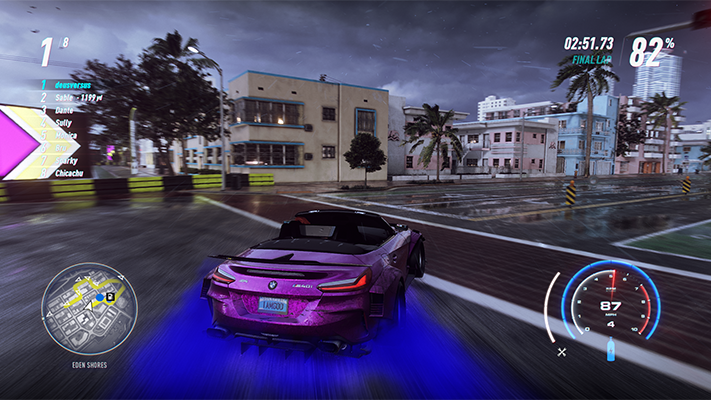
Instead, the game provides two methods of drifting to meet every kind of turn in the game.
Your standard drift is, by default, hotkeyed to a novel release-turn-gas mechanic that has you ease off the accelerator, lean into the curve, then heavy back into the gas in order to put your car into drift-physics.
You can then steer into or out of the drift to make the angle of your turn as wide or narrow as needed. This mechanic can be altered via an in-game menu (i.e. Right on the D-pad) to change it back to a more familiar break-drift mechanic.
Initiating a drift can be, in the heat of the moment, trickier than anticipated. The upside to this change is a more-direct means of initiating the drift, the downside being that if you miss the drift, all you’ve done is hit the breaks mid-race.
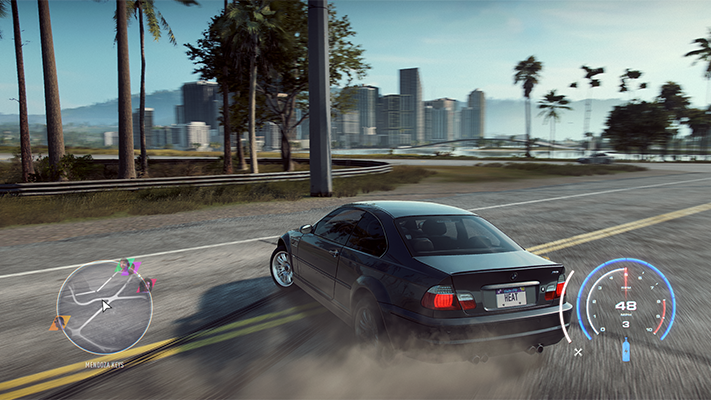
Next is the the handbrake drift. If applied correctly, a quick tap of the handbrake can send you into a wide drift still suitable for many obtuse turns.
More often, this can be used for sudden, sharp turns that you may not have anticipated. It will almost always lessen your cornering speed more than a preempted, standard drift, but with the fuzz sending in choppers and armored vehicles, that’s not always an option.
Drifts of this type also become imperative for successive, diametric turns.

The game doesn’t demand perfection, but it does demand competence.
Mastering how and when to drift is an essential component of winning races, gaining reputation points (which unlock performance upgrades), and “making bank” (their words, not mine).
Heat does away with an automatic day-night cycle, instead letting the player choose as they leave the garage. Which you choose affects what sorts of races will be available to you and subsequently, the rewards that can be earned from those races.

Daytime races earn you money in spades, while nighttime races earn you the respect of your fellow racers and gearheads. Most story-campaign races will reward you with both.
The first sort are legal and will not warrant the ire of the police, despite often taking place on similar tracks as their after-dusk counterparts.
The game certainly has some balancing issues. It can be very hard to catch up once you’ve fallen behind–which can happen at no fault of your own.

You simply won’t win every race. Sometimes your opponents just have a very good race, and you’ll likely become acquainted with the start-menu’s quick-restart function (which is disabled during police pursuits).
More importantly, the degree to which police act as murder-happy zealots is absolutely bonkers. Early in the game, the police are largely pushovers, but once you reach a certain heat level (more on this below) the game goes full Grand Theft Auto.
Whether or not you lose the police often feels less like a factor of your driving and more like a roll of the dice.

A simple police cruiser catching eye of you can quickly become a full-on high-speed chase.
One of the core functions of the game is your “heat level”–a euphemism for how pissed off you’ve made the police. The higher your heat level when you check in for the night, the more respect you’ll earn; also, the more likely the cops are to throw everything they have at you.
If you do manage to escape (hint: cops will often not follow you over large jumps), you will be left with a police force doubled down on finding and neutralizing you (i.e. your heat level).
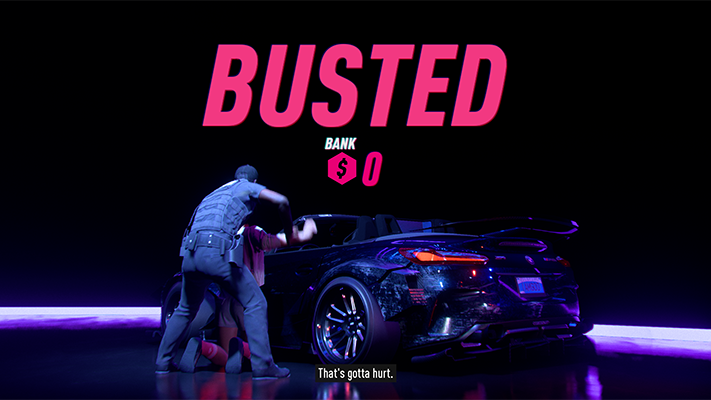
It really doesn’t make sense to not earn yourself at least a heat level of two before checking-in for the night in order to double-up on those nighttime gains, but be wary of taking it too far.
The higher level your heat is, the less likely you are to make it back to the garage at all. If you get busted, you will lose your bonus multiplier, any respect gained that night, and a percentage of your overall bank.
This can feel like a major setback, both in terms of continuing the story, which is locked behind predetermined Rep levels, and in terms of upgrading your ride, which can be fairly expensive as the game progresses.
A nice cost-cutting feature is that previously purchased parts that are not currently in use can be shared among the remaining cars in your garage.
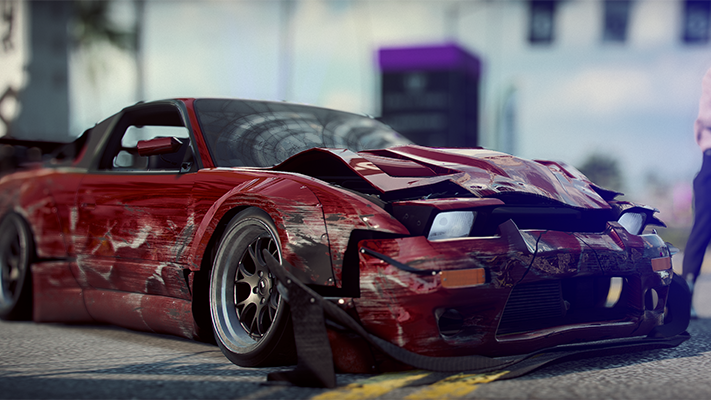
As the game proceeds, you’ll earn exponentially more money from individual races. Conversely, part-prices increase linearly, helping to alleviate the burden of virtual poverty.
Speaking of turning in for the night, your car will suffer significant damage through the course of racing. The five-0 are quick to smash their ridiculously expensive cars into your ridiculously expensive car, doing immediate damage.
This mechanical love affair will often enough corral you off into a building, large tree, or other solid object begging to make your acquaintance. This damage can be repaired by simply returning to a garage (either via fast travel, or when the heat is up, by driving back home the old fashioned way).

The open-world of Palm City is littered with destructible objects that do significantly less damage to your vehicle. Learning which are which can help you manage which shortcuts are worth taking and which are not.
These decoratives help populate Palm City’s wide city-streets and broad country-roads (which were clearly designed to accommodate the game’s relatively stiff arcade physics).
In general, Palm City’s raceways are very forgiving and allow at least some leniency in how you approach each race, though this changes depending on the type of race.
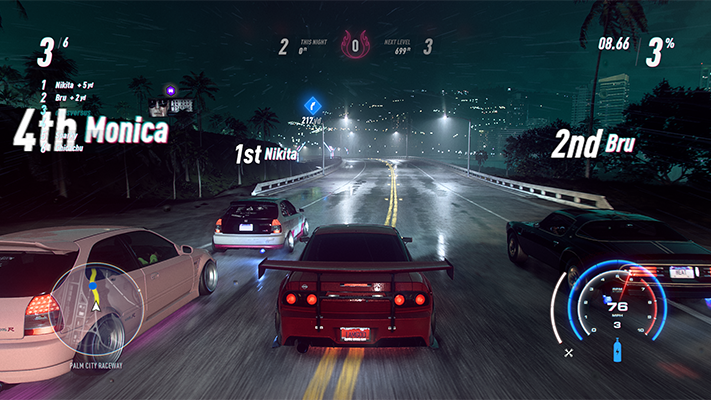
Need for Speed: Heat offers a relatively small variety of race types and sub-types, broken down into the two archetypal categories of Race vs Drift.
These categories of races often feel qualitatively different based largely on where they take place.
Drift race-types are less concerned with speed than with form, and award points based on the duration of your drift (awarding bonus points for proximity to multiplier-cancelling obstacles).
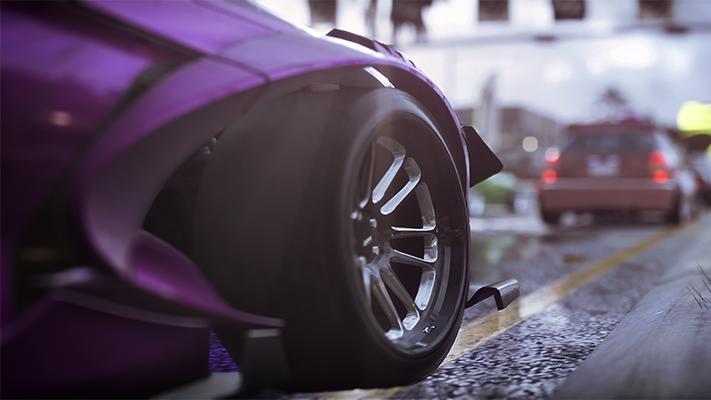
Rather than competing with an opponent to get-there-first, you are tasked to best a certain drift score.
The difficulty of these types of “races” often lies in the wide variety of tracks they take place on; from winding downhill spirals to tight industrial shipyards. Finding the right combination of speed and form can present a significant challenge, especially early on when you’re lacking relevant upgrades.
Tuning your car toward “Drift” specs in the garage can enable you to enter drifts merely by steering, no clutch-kick or handbrake required. This will significantly help in these sorts of races.
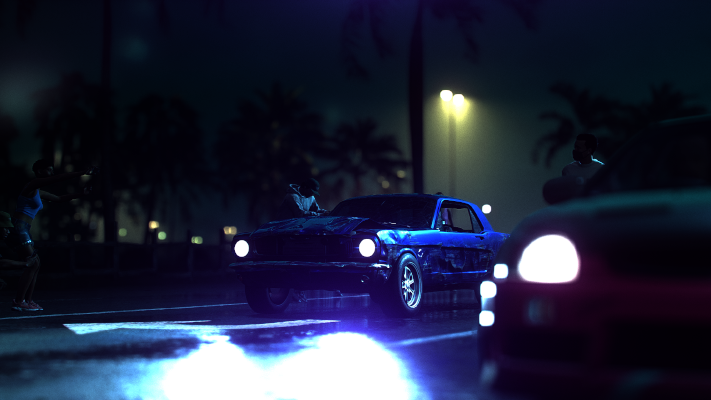
Conventional races come in the standard sub-types of Circuit vs Sprint, with the key difference being the number of laps (i.e. one long track vs multiple laps around the same track). These need little in the way of explanation.
It does beg mentioning that the shape of the tracks can be dramatically different, however.
Some races involve very small, very tight circuits around inner-city streets, while others more resemble the “downhill drift” and “canyon drift” races of bygone titles (starting high in the mountains and working their way back to relative civilization).

Need for Speed: Heat‘s car roster consists of a selection of licensed on-road and off-road vehicles from well-known manufactures from every socioeconomic class: Acura, Aston Martin, Audi, BMW, Chevy, Ferrari, Ford, Honda, Jaguar, Lamborghini, Mazda, McLaren, Mercedes, Nissan, Porsche, and Volkswagen–to name a few.
Most of the vehicles are sports-cars and coupes, though a few larger vehicles have found their way into the game. There don’t seem to be any vehicles of the fictional variety.
This lineup is more than acceptable, though your author had held onto hopes that they might sneak in Need for Speed III’s El Niño. Alas, we’re left with naught but the likes of the vastly inferior Koenigsegg Regera 2016 Hypercar.
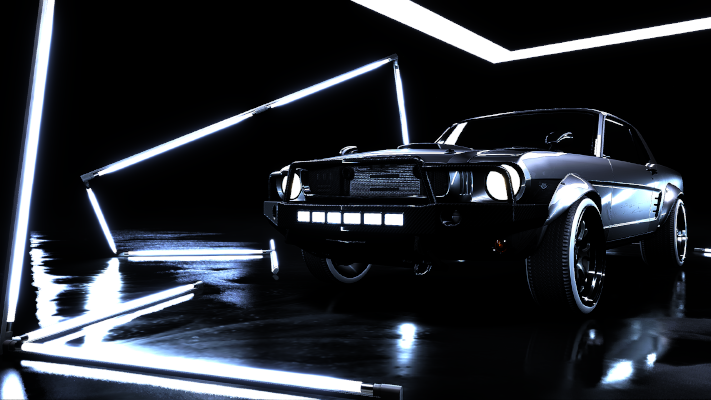
Whether you’re drifting, racing, or just free-driving, time spent in Palm City is quite satisfying, both viscerally and visually.
Need for Speed: Heat may not aspire to the no-holds-barred realism of some other modern titles, but what it lacks in pure graphical prowess it makes up with stylistic design and a color palette that feels like optical caviar.
The game provides a meaty collection of aesthetic customizations for your ride. Vanity items, such as underglow, nitrous color, tire smoke, etc. are universal, though body customizations tend to be specific to certain car models. There are, regardless, enough options to make your car feel truly yours.
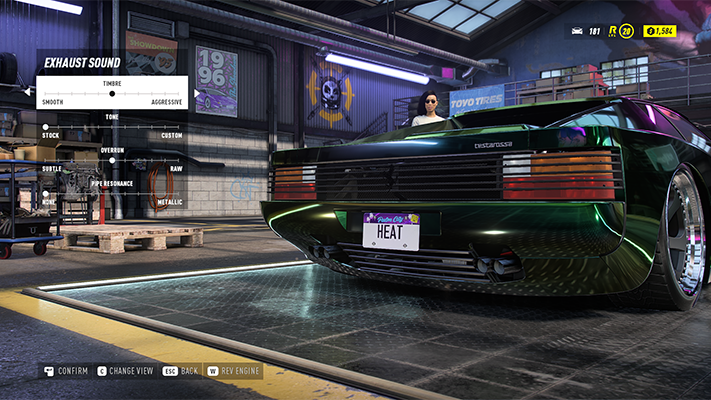
In addition to these visual customizations, Heat also lets you adjust the audible effects your car produces.
You can tweak, via slider bars, the timbre, tone, overrun, and resonance of the exhaust system to create a car that doesn’t just look unique, but also sounds unique.
Sadly, Heat‘s soundtrack is not customizable. This is the sole aspect of the game that stands out as an utter disappointment. Need for Speed: Heat‘s soundtrack could be described as “modern”, loaded with hip-hop and electronic music (think dubstep) that may appeal to some.

Your author, who is a life-long fan of rap & hip-hop as a genre, would describe Heat‘s soundtrack as pandering trash.
With the exception of a few notable, stand-out artists (mmm, Sa-Roc), the game effectively plays to cultural stereotypes that may have seemed kosher in 2001 but are, in 2019, hard to describe as anything but short-sighted-bordering-on-exploitative.
Perhaps if the game offered a wide variety of music genres, controllable via a “radio” menu (ala Grand Theft Auto), the “infusion” (read as: superimposition) of urban culture into the game would be at least digestible.
As it is, the games soundtrack is best left on mute whilst you pull up Spotify or other music streaming app of choice. You can thank me later.
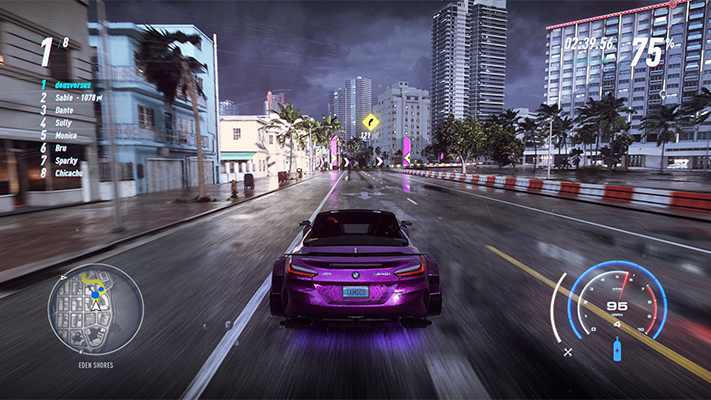
Elements of the game play like direct homages to previous titles, while others feel like a doubling down on the best aspects of modern titles while doing away with the worst.
Heat isn’t a game that redefines the genre so much as it back-pedals on recent developments that left the genre in a sour state.
The game offers a lot in way of old-fashioned arcade fun, performance and aesthetic customization, and the sheer excitement of law-breaking adrenaline binges. The world isn’t always the prettiest (the nighttime neon spectacle largely trumps the city at noon), but it offers a lot by way of ’80s throwback stylistic choices.
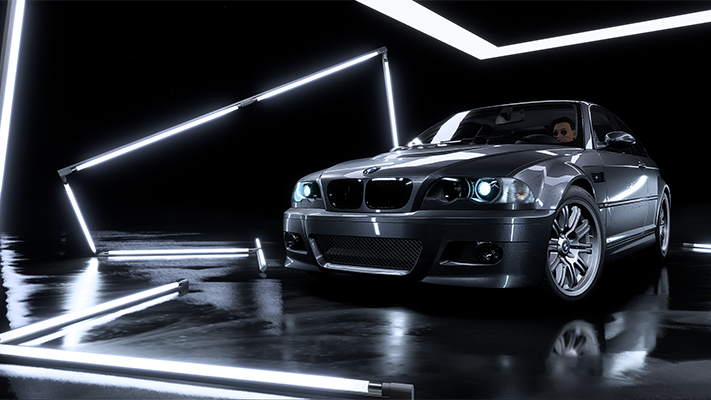
The races in Need for Speed: Heat feel like hand curated nostalgia. Ultimately, the game hits home where it matters: Despite its flaws, it is a lot of fun.
If you’re a fan of titles like NFS: Underground, NFS: Most Wanted, and NFS: Carbon, you’ll likely find Need for Speed: Heat to your liking. Even newcomers to the genre will be able to see what the hype is about.
It’s a game that delivers on a promise, but may still not be for everyone. And, could someone please tell EA to change the station?
Updated: As @EmpReb mentions in the comments, the driving mechanics are highly configurable via the same in-game menu used to change the drift controls. As he says, “Everything from drift style to downforce (i.e. grip) to steering sensitivity to traction control” can be customized to make Heat control exactly how you want it to.
Need for Speed: Heat was reviewed on Windows PC using a review copy provided by Electronic Arts. You can find additional information about Niche Gamer’s review/ethics policy here.